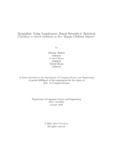| dc.contributor.advisor | Akon, Mujtahid Al-Islam | |
| dc.contributor.advisor | Mostakim, Moin | |
| dc.contributor.author | Mahtab, Motahar | |
| dc.contributor.author | Haque, Monirul | |
| dc.contributor.author | Hasan, Mehedi | |
| dc.date.accessioned | 2022-08-28T10:07:16Z | |
| dc.date.available | 2022-08-28T10:07:16Z | |
| dc.date.copyright | 2022 | |
| dc.date.issued | 2022-01 | |
| dc.identifier.other | ID 18301023 | |
| dc.identifier.other | ID 18301055 | |
| dc.identifier.other | ID 18301052 | |
| dc.identifier.uri | http://hdl.handle.net/10361/17128 | |
| dc.description | This thesis is submitted in partial fulfillment of the requirements for the degree of Bachelor of Science in Computer Science, 2022 | en_US |
| dc.description | Cataloged from PDF version of thesis. | |
| dc.description | Includes bibliographical references (pages 38-41). | |
| dc.description.abstract | The art of luring us to click on certain content by exploiting our curiosity is recognized
as clickbait. Clickbait might be aggravating at times because it is misleading.
Several studies have worked on the detection of clickbait in online platforms as we
transition from the Information Age to the Age of AI. Nonetheless, predicting clickbait
in Bengali new articles is still a work in progress. Here, we use deep learning,
the process of extracting pattern or feature from data using neural networks, to
determine whether an online Bengali article is clickbait or not. We scrape data
from online Bengali news articles, manually annotate them and employ deep nerural
network architectures like CNN, Bi-LSTM,Bi-GRU and pre-trained fine-tuning
language representation approaches –i.e. BERT, BanglaBERT, M-BERT to provide
inputs for various types of classifiers. Finally, we evaluate the classifiers’ outputs
and choose the best outcome to predict clickbait in Bengali news articles. | en_US |
| dc.description.statementofresponsibility | MD. Motahar Mahtab | |
| dc.description.statementofresponsibility | Mehedi Hasan | |
| dc.description.statementofresponsibility | Monirul Haque | |
| dc.format.extent | 41 pages | |
| dc.language.iso | en | en_US |
| dc.publisher | Brac University | en_US |
| dc.rights | Brac University theses are protected by copyright. They may be viewed from this source for any purpose, but reproduction or distribution in any format is prohibited without written permission. | |
| dc.subject | Clickbait | en_US |
| dc.subject | Deep learning | en_US |
| dc.subject | Bengali | en_US |
| dc.subject | Online news | en_US |
| dc.subject | Prediction | en_US |
| dc.subject | Binary classification | en_US |
| dc.subject | BERT | en_US |
| dc.subject.lcsh | Cognitive learning theory (Deep learning) | |
| dc.subject.lcsh | Neural networks (Computer science) | |
| dc.title | BanglaBait: using transformers, neural networks & statistical classifiers to detect clickbaits in New Bangla Clickbait Dataset | en_US |
| dc.type | Thesis | en_US |
| dc.contributor.department | Department of Computer Science and Engineering, Brac University | |
| dc.description.degree | B. Computer Science | |

